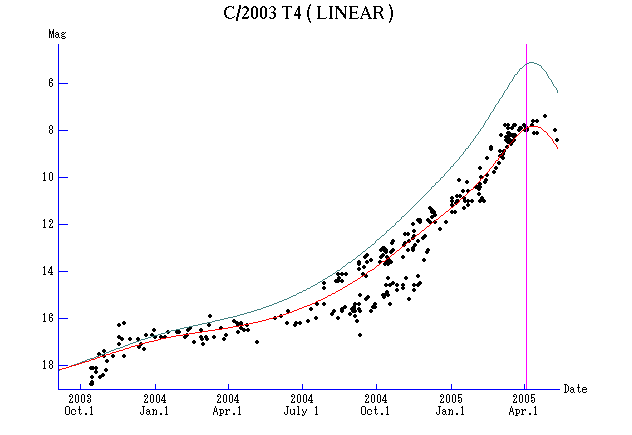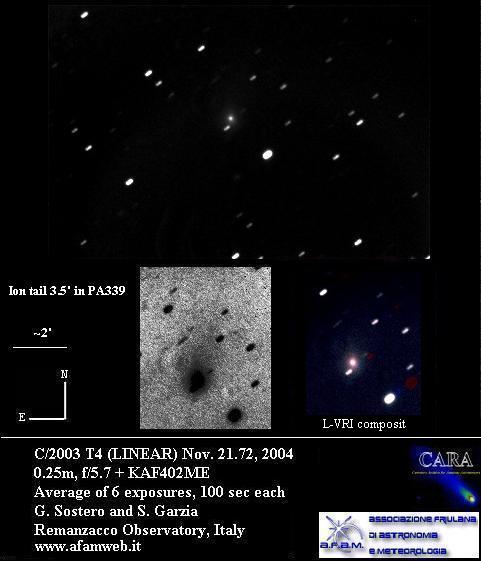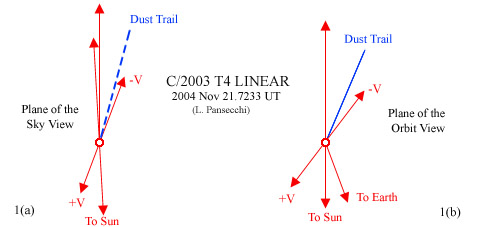Unusual Comet C/2003 T4 ( LINEAR )
|
Home page |
Updated on June 21, 2005 |
![]()
|
|
![]()
|
| H10 | absolute magnitude |
| delta | geocentric distance |
| r | heliocentric distance |
The coefficient of log r in this formula means brightness evolution of a comet. The coefficient of a typical parabolic comet is 10.
However, in the case of Comet C/2003 T4 ( LINEAR ), it was much lower than usual, The actual formula was as follows.
m1 = 8.0 + 5 log delta + 7.0 log r
The slow brightness evolution continued all through the observation period, from the discovery to the perihelion passage, for over one and a half years.
The heliocentric distance decreased from 6.5 A.U. to 0.85 A.U. in this period. H2O molecules must have sublimated in this period, but no evident change of brightness evolution was observed.

Red curve is: m1 = 8.0 + 5 log delta + 7.0 log r
Green curve is: m1 = 5.5 + 5 log delta + 10 log r
 Reddish color
Reddish color
In early 2004 November, the comet was around 13.0 mag visually. But it was reported much brighter in Rc or Ic band at the same time.
| Date | Mag. | Observer |
|---|---|---|
| Nov. 3.77 | 12.9 | A. Baransky |
| Nov. 4.80 | 12.8 | A. Baransky |
| Nov. 4.83 | 12.4 | Reinder J. Bouma |
| Nov. 8.87 | 13.1 | Vitali Nevski |
| Nov. 8.96 | 12.4 | Reinder J. Bouma |
| Nov. 9.82 | 12.7 | Seiichi Yoshida |
| Date | Mag. | Observer |
|---|---|---|
| Nov. 8.71 | 11.5 | Rolando Ligustri |
| Date | Mag. | Observer |
|---|---|---|
| Nov. 9.77 | 11.8 | Giovanni Sostero |
Usually, visual brightness estimation becomes brighter than CCD (red or infrared) measurement. But in this case, visual brightness is much fainter than CCD observations.
Giovanni Sostero operated multicolor and unfiltered CCD photometry on 2004 November 21. The resulting color index V-I was close to +1 (the Sun has a V-I close to 0.7). Apparently the comet was a little red compared to the solar colors, even considering the error bars (+/- 0.1 magn in each filter, ~+/-0.2 magn for the V-I).
| Aperture | V mag | Ic mag | Unfiltered CCD mag |
|---|---|---|---|
| +1'.0 | 13.0 | 12.0 | 11.9 |
| +0'.5 | 13.6 | 12.6 | 12.6 |
| +0'.2 | 14.4 | 13.5 | 13.5 |
Sostero commented that very few comets that he measured has shown a V-I~1 in the past. One notable example was C/2002F1 (Utsunomiya); it was very dusty, with a well developed type II tail.
Sostero reported that the Afrho (a parameter somehow linked to the dust production within the coma) measurements extracted from his one night stand, provided a value of the order of 1400cm. This amount is a little high considering the sun-comet distance (almost 2.5 A.U.), but nothing special, provided that 29P/Schwassmann-Wachmann is able to sustain an emission of several thousands cm at 5 A.U.
Antonio Milani (CARA, Italian Comet Section) commented about another possibility: if the coma is C2 depleted, then the visual estimations (and the CCD-V) will be obviously fainter, because our eye is very sensitive to the Swan-band emissions of C2.
Michael Mattiazzo pointed out that the Comet C/2003 T4 ( LINEAR ) was particularly faint (when compared to visual measurements) on SWAN images throughout the perihelion passage. This would indicate that water sublimation (via its lyman alpha emission) from C/2003 T4 was considerably lower than that of a typical comet.
 Possible dust trail
Possible dust trail
 Possible dust trail detection on 2004 November 21
Possible dust trail detection on 2004 November 21
Giovanni Sostero observed the comet on 2004 November 21 using the 0.25-m reflector and CCD camera with Cousins I filter.

Giovanni Sostero commented that the 3.5 arcmin ion tail is visible in p.a. 339 degree. But I found it is possible a dust trail of the comet, not an ion tail.
I calculated the apparent directions of the ion tail and dust tail on that day. The ion tail must extend in p.a. 3 degree, and the dust tail must extend in p.a. 357 degree. They are completely different from the "tail" on Giovanni Sostero's image.
I also calculated the apparent direction of the orbit of this comet on that day, which is in p.a. 159 and 339 degree, which completely coincides with the "tail" on Giovanni Sostero's image.
| Tail/Dust trail | Position angle |
|---|---|
| ion tail | 3 degree |
| dust tail | 357 degree |
| dust trail | 159 and 339 degree |
The "tail" on Giovanni Sostero's image looks both in p.a. 159 and 339 degree. That also suggests the "tail" is the dust trail.
If it is really the dust trail of Comet C/2003 T4 ( LINEAR ), it must be the first time to detect a dust trail of a parabolic comet.
Giovanni Sostero forwarded the discussion among the Italian Comet Section. According to the experts, the geometrical circumstances of this apparition, as calculated by Yoshida, are actually compatible with a dust trail (and much less with other features like anti-tails, whether apparent or real, etc.).
Note that the eccentiricity around the perihelion passage of this comet is hyperbolic, but it actually has a long periodic orbit. The original 1/a becomes +0.000242 at 250 A.U. based on Michael Mattiazzo and Sebastian F. Hoenig's calculation.
 Possibility of anti tail
Possibility of anti tail
Masayuki Suzuki pointed out the anti tail of Comet C/1956 R1 ( Arend-Roland ), and the similarity of the feature to the "tail" of Comet C/2003 T4 ( LINEAR ).
http://cometography.com/lcomets/1956r1.html
I calculated the inclination of the comet's orbital plane from the earth of C/1956 R1 when the spearlike anti tail was visible. It was from April 22 to the end of the month in 1957, when the earth was passing across the comets's orbital plane. In that period, the inclination was less than 5 degree.
On the other hand, the inclination of C/2003 T4's orbital plane on 2004 November 21 was 13 degree. Probably it is too large to make the anti tail spearlike.
I also simulated the possibility of anti tail using a commercial planetarium software StellaNavigator (AstroArts Inc.). In the case of C/1956 R1, the spearlike anti tail was observed just after the perihelion passage. The simulation also says it is reasonable that the anti tail appeared at that time if the tail length was 1 A.U. or so. Actually, it had a long tail at that time.
On the other hand, the simulation says that it is impossible that the anti tail of C/2003 T4 appears on 2004 November 21, even if the dusts are small or large, or even if the dust tail is so large as several A.U., because it is still far from the perihelion passage.
 Follow up observations
Follow up observations
The earth passed accross the orbital plane of C/2003 T4 in late December in 2004, when the apparent direction of the ion tail, dust tail and dust trail coincided and we could not distinguish them. So it was impossible to confirm the dust trail from early December to early January.
After 2005 January, the difference between position angles of the tails and dust trail became larger and larger, and it became easier and easier to distinguish them. In 2005 March, the difference must have been 90 degree.
However, the dust trail was not confirmed by others after 2004 November 21.
C/2003 T4 ( LINEAR )
Date r d Elong m1 Tail(') p.a. Earth Dir. Orb(pa,da)
2004-12- 1 2.194 2.262 73 12.2 63.0 1.6 ( 23, 10) (164,117)
2004-12-11 2.064 2.170 70 11.9 68.5 359.1 ( 25, 6) (168,113)
2004-12-21 1.934 2.092 67 11.6 73.9 355.7 ( 27, 2) (172,110)
2004-12-31 1.802 2.024 62 11.3 79.0 351.4 ( 28, -2) (175,107)
2005- 1-10 1.671 1.963 58 11.0 83.9 346.2 ( 29, -7) (177,105)
2005- 1-20 1.539 1.904 53 10.7 88.9 339.7 ( 28,-13) (179,103)
2005- 1-30 1.408 1.841 49 10.4 94.3 331.9 ( 26,-18) (180,101)
2005- 2- 9 1.281 1.771 45 10.0 101.0 322.3 ( 23,-23) (180,100)
2005- 2-19 1.160 1.688 41 9.6 110.6 311.0 ( 19,-29) (178, 99)
2005- 3- 1 1.049 1.591 40 9.2 125.0 297.9 ( 14,-34) (176, 99)
2005- 3-11 0.955 1.479 39 8.7 146.7 283.6 ( 9,-40) (172, 97)
2005- 3-21 0.887 1.357 40 8.3 176.8 268.7 ( 4,-47) (167, 94)
2005- 3-31 0.852 1.236 43 8.0 212.8 253.7 ( 3,-53) (159, 89)
 Luigi Pansecchi's consideration
Luigi Pansecchi's consideration
Luigi Pansecchi obtained from Giovanni Sostero the orginal FIT image and measured it accurately.
Before all, Pansecchi found that such image needs to be rotated clokwise of 1.521 degree for the direction to the North passing through the comet nucles to be exactly parallel to the minor side. Then, Pansecchi measured the orientation of the streamer (i.e., of the supposed dust trail) and found the it lies in position angle PA(dt) = 344.9 degree +/- 0.1 degree. Finally, taking the following orbital elements for the current standard epoch from MPC 52315:
C/2003 T4 (LINEAR) Epoch 2005 Jan. 30.0 TT = JDT 2453400.5 T 2005 Apr. 3.6258 TT MPC q 0.849661 (2000.0) P Q z -0.000718 Peri. 181.6754 +0.0697072 +0.0543399 +/-0.000008 Node 93.9042 -0.9032473 +0.4272613 e 1.000610 Incl. 86.7619 -0.4234209 -0.9024938
Pansecchi computed, for the date of the CCD image ( 2004 Nov 21.7223 UT, at midexposure), the following parameters:
- PA(prv)
- Position angle of the projection on the sky of the Sun-comet prolonged radius vector = 3.2 degree.
- PA(+v); PA(-v)
- Position angle of the projection on the sky of the comet velocity vector, tangent to the comet orbit in the comet nucleus, in the direction of the comet motion (+V) and in the opposite direction (-V) = 159.4 degree ; 339.4 degree
- BETA
- Cometocentric latitude of the Earth, that is, the inclination of the line of sight to the plane of the comet orbit = 13.6 degree
The situation on the plane of the sky is illustrate in Fig. 1(a)
The above position angles, together with the PA(dt), have been then projected into the plane of the comet orbit, on the assumption that the observed structure lies in such a plane, as a dust trail should be. The results are shown in Fig. 1(b)

Pansecchi concluded that the supposed dust trail does not coincide with the comet orbital path. This is more evident in the orbital plane view where the trail appears to lie almost midway between -V and the Sun-comet prologed radius vector. This might mean that the trail is really a normal dust tail. As to the sunward extension of the "trail" in the original image, there is a star (partly embedded in the coma) just in that position. However, further observations will be necessary for a definitive conclusion.
 Strong non-gravitational effects
Strong non-gravitational effects
Kenji Muraoka obtained the unusually strong non-gravitational effects in the orbit calculation of Comet C/2003 T4.
The non-gravitational effects seem to start affecting when the heliocentric distance becomes smaller than 2 A.U. long before the perihelion passage.
Muraoka found that the parameters of non-gravitational effects became unusually large, and the orbit cannot be calculated properly, when using Marsden's formula. On the other hand, the orbit can be calculated properly using Yabushita's formula on the non-gravitational effects, although the parameters are still large.
On the effect of non-gravitational processes on the dynamics of nearly parabolic comets ( M.N.R.A.S. 283, 347-658 1996)
Comet C/2003 T4 ( LINEAR )
The following improved orbital elements by Kenji Muraoka,
are from 888 observations 2003 Oct. 13 to 2005 Apr. 20,
including 8 Planets, Moon and 3 minor planets perturbations
and non-gravitational effect of style II.
The mean residual is +/- 0.99 arc seconds.
Epoch = 2005 Apr. 20.0 TT JDT = 2453480.5
T = 2005 Apr. 3.64596 +/- 0.00034 (m.e.) TT
Peri. = 181.64400 +/- 0.00044
Node = 93.90346 +/- 0.00011 (2000.0)
Incl. = 86.76127 +/- 0.00007
q = 0.8498569 +/- 0.0000071 AU
e = 0.9998745 +/- 0.0000054
1/a = +0.0001476 +/- 0.0000064 1/AU
A1 = +14.201 +/- 0.374
A2 = -1.71904 +/- 0.19570
( P = 557383 years )
orig. 1/a = +0.0003126
Comet C/2003 T4 ( LINEAR )
The following improved orbital elements by Kenji Muraoka,
are from 869 observations 2003 Oct. 13 to 2005 May 12,
including 8 Planets, Moon and 3 minor planets perturbations
and non-gravitational effect ( Yabushita's Theory ).
The mean residual is +/- 0.64 arc seconds.
Epoch = 2005 Apr. 20.0 TT JDT = 2453480.5
T = 2005 Apr. 3.64863 +/- 0.00044 (m.e.) TT
Peri. = 181.64846 +/- 0.00031
Node = 93.90379 +/- 0.00007 (2000.0)
Incl. = 86.76155 +/- 0.0000470
q = 0.8498700 +/- 0.0000053 AU
e = 1.0000515 +/- 0.0000038
1/a = -0.0000606 +/- 0.0000045 1/AU
A1 = +8.441 +/- 0.135
A2 = -0.14859 +/- 0.06139
orig. 1/a = +0.0002592
![]()